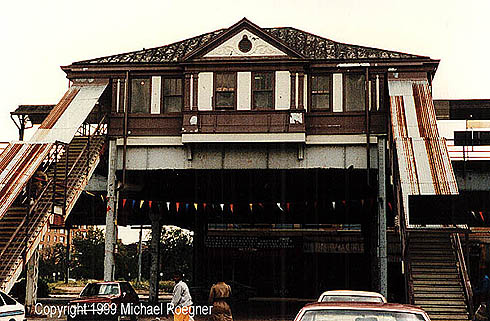
No, this isn't
King
Drive. It's the
University station, looking south in 1985.. Except for the
shape of the panes of glass in the windows, the two stations
were identical. By 1985, the station was in bad need of repair,
never having received the overhaul it was promised only
three years before. For a larger view, click
here.
(Photo from the Collection of Michael
Roegner)
|
University
(1200E/6300S)
University Avenue and 63rd
Street, Woodlawn
Service
Notes:

|
Green Line:
Jackson Park branch
|
Quick Facts:
Address: 1200 E. 63rd
Street
Established: April 23, 1893
Original Line: South Side Rapid Transit
Previous Names: Lexington Avenue
|
Skip-Stop Type:
|

|
Station
|
Rebuilt: n/a
Status: Demolished
History:
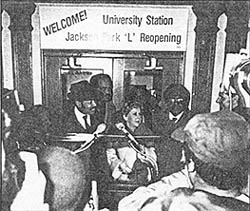
Mayor Byrne
addresses a platform crowd at the reopening of the
University Avenue rapid transit station on the
Jackson Park elevated branch. Accompanying the
mayor are (from left to right) Committeeman Ray
Castro, 7th Ward; CTA Board Member Howard Medley;
Alderman Tyrone Kenner, 3rd Ward; TWO President
Leon Finney; City Treasurer Cecil Partee; and CTA
Chairman Michael Cardilli. The pilasters framing
the doors resemble those at King
Drive,
indicating similar architecture. (Photo from CTA
Transit News) |
University, originally called Lexington Avenue, opened
April 23, 1893 as part of the South Side Rapid Transit's
extension from 39th Street to
Jackson Park for the World's Columbian Exposition. The
design and ornamental details on this station are identical
to those on the original station at King
Drive a mile west, which would appear to establish a
common architect. (Some have conjectured they were designed
by William Gibb, who also designed several stations on the
Northwestern Elevated main line.) This station, and King
Drive, featured decorated pilasters, large double-hung
windows and unique ornamentation in the pediment, giving the
structure a Colonial Revival feel.
The Columbian Exposition proved to be both a blessing and a
problem for the South Side Rapid Transit. The "L" proved to be a
popular way to get to the exposition and ridership was strong. But just as the fair boosted ridership, the closure of
the fair in October 1893 caused it to crash quickly. Many areas that the South Side "L" ran through were still sparsely populated in the 1890s and after the fair closed there was little traffic to support some stations. Two decades later a long-time "L" trainman recalled that, "for a long time after the World's Fair the stations at South Park and University avenues were closed, as there was no traffic at those points."1 Both stations subsequently reopened as the neighborhoods around them developed and became more populated.
Around 1970, the CTA required inbound boarding only at
University, in effect until it became the terminal in 1982
(when you couldn't go eastbound anyway).
On March 4, 1982, service on the Jackson Park branch was
suspended south of 61st Street due
to structural defects in the Dorchester bridge over the
Illinois Central Railroad. The City Department of
Transportation come up with a number of responses, which
included cutting service to Dorchester on the west side of
the IC tracks, abandoning the Jackson Park branch altogether
and replacing the IC bridge and restoring service to the Stony Island terminal, the
latter of which Mayor Byrne supported. On December 12, 1982,
service was restored as far as this stop. The defective
bridge was later demolished.
The CTA and city spent $56 million modernizing the branch
and the three reopened stations. Then-Mayor Jane Byrne
announced a four-point program that included working closely
with the Woodlawn community and The Woodlawn Organization
(TWO) to promote economic development along East 63rd Street
and building a new Jackson Park branch terminal at Dorchester,
providing direct access to the Illinois Central commuter
line and a CTA bus terminal.
On December 18, 1993, the northeast and southeast stairways at University station were closed.
University remained the east terminal of the Jackson Park line until the Green Line closed for renovation in 1994.
Maps began to list Dorchester,
a few blocks east, as the terminus just before the closing,
anticipating a new terminal facility that was to be completed
there by the time the line renovation was completed, but this never came to
pass. University never reopened after the Green Line reentered service in May 1996, when Cottage
Grove-East 63rd became the end of the line. This station
and rest of the East 63rd branch east of Cottage
Grove remained abandoned, pending a decision on its
future, which came in September, 1997: its demolition.
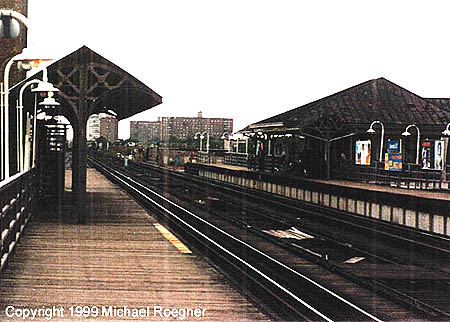
A view from the University
eastbound platform looking west, with Cottage
Grove station in the
distance, in 1985. The inbound station house is on the
right. For a larger view, click here.
(Photo from the Collection of Michael
Roegner)
|



|
crt4293.jpg (97k)
crt4306.jpg (83k)
Car 4293, in its orange and green paint scheme, is at the
rear of a Jackson Park train stopping at University in the
top photo. Below, car 4306 is on the rear of a northbound
Howard Express train at the same location. Flag holders were
added to the rapid transit cars starting in 1929, flags were
flown on holidays, a practice the Surface Lines and Chicago
Motor Coach also followed. This custom is still observed by
Pace, the suburban bus operating division of the RTA. (Photo from the Jeff Obarek
collection) |
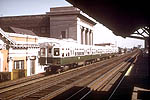
|
cta6372.jpg (124k)
Car 6372 leads a northbound Jackson Park-Howard "B" train
(although it is actually going west here) at University on
October 2, 1972. (Photo by Steve Zabel,
Collection of Joe Testagrose) |
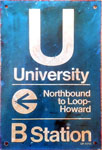 |
university-P-8_KDRsignNB.jpg (105k)
This "KDR"-style
symbol sign from the northbound platform at University was
installed in 1982, as part of a refurbishment of this and other Jackson Park branch stations prior to their reopening following to a temporary service suspension. The design of this sign is typical of this type and vintage: large first letter of the station name with the full name under it; a "KDR arrow" pointing in the direction of travel with the direction and destination in the middle; and the skip-stop station type at the bottom. What is unusual is the color -- in the KDR signage system, green was used for 'B' station signs; blue backgrounds were for 'AB' or All-stop stations. It is not clear why University's symbol signs (and station name signs) were blue instead of green, although the signs Cottage Grove and King Drive, which were also 'B' stations and received rehabs and new signs at the same time, were similarly treated. (Sign courtesy of Bill Wulfert) |
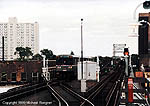
|
university03.jpg
(128k)
Looking east toward a 2600-series
Jackson Park B train heading to the crossover to return back
west in 1985. Visible in the distance are the remains of the
Dorchester station, the
Dorchester bridge, and the tall brown building on the right
is the Illinois Central Terminal building.
(Photo from the Collection of Michael
Roegner)
|
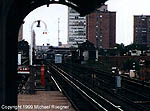
|
university05.jpg
(91k)
Same view as university04.jpg,
only with a closer view of Cottage
Grove. (Photo
from the Collection of Michael Roegner)
|
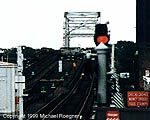
|
university06.jpg
(100k)
Same view as university03.jpg,
with a close-up of the Dorchester
station remains and IC bridge.
(Photo from the Collection of Michael
Roegner)
|

Notes:
1. "Reminiscences of an "L" Trainman." The Elevated News. 1920 February, p. 10.












